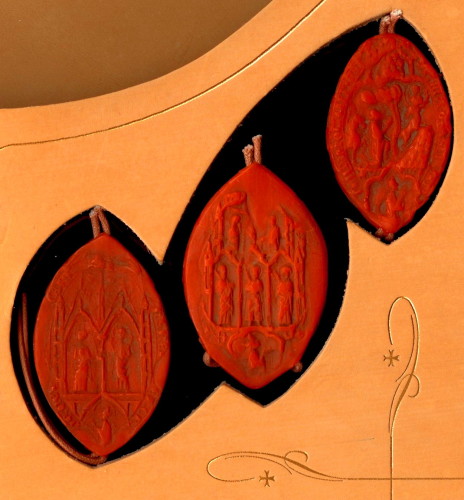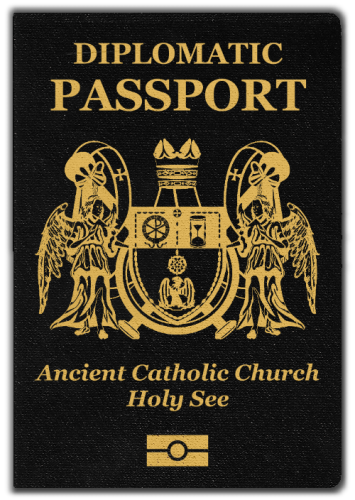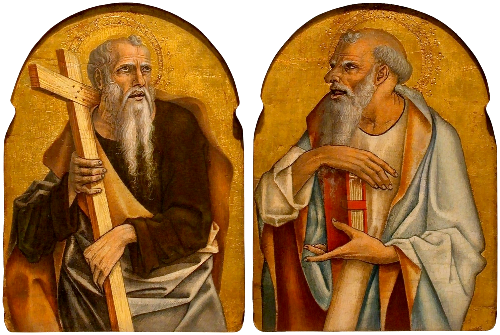- Home
- Legitimacy
- Pontifical Authority
Pontifical Status & Recognition:
Pontifical Authority & Canonical Recognition of Ancient Christian Denomination
Vatican Recognition of Ancient Catholicism

Vatican Triple Pontifical Cardinal Seals, on the ‘Chinon Parchment’ (1305 AD) Secret Archives replica set, authenticated reproduction 2007 AD
 Represented by the 12th century Ancient Apostolic Church, the legitimacy, validity and inherent ecclesiastical sovereignty of the 1st century independent denomination of Ancient Catholicism is solidly recognized by the Vatican, by five Papal Bulls, three Papal Decrees, and multiple provisions of Roman Canon law:
Represented by the 12th century Ancient Apostolic Church, the legitimacy, validity and inherent ecclesiastical sovereignty of the 1st century independent denomination of Ancient Catholicism is solidly recognized by the Vatican, by five Papal Bulls, three Papal Decrees, and multiple provisions of Roman Canon law:
As the continuation of the Ancient Priesthood of Solomon of Knights Templar heritage, Ancient Catholicism is directly recognized by the Vatican Code of Canon Law as verified by “learned authors” (Canon 19) [1] [2] and as “immemorial customs” and “centennial customs” (Canon 26) [3], by the Temple Rule of 1129 AD as a Papal Decree [4], and the Papal Bulls Omne Datum Optimum of 1139 AD [5] supported by Milites Templi of 1144 AD [6] and Militia Dei of 1145 AD [7].
As the founding origins and underlying substance of the Independent Church Movement, Old Catholic Movement, Reformed Catholic Movement and Liberal Old Catholic Movement, Ancient Catholicism is additionally recognized by the Vatican Code of Canon Law as validly “incardinated” Independent Bishops not subject to any external authority (Canon 266) [8], by the Papal Decree of the Fourth Lateran Council of 1215 AD recognizing “independent Churches” (Canon 3) with “ancient privileges” of “their jurisdiction” (Canon 5) [9], the Papal Decree creating the Gregorian Egyptian Museum in 1839 AD [10], and the Papal Bulls Debitum Pastoralis of 1520 AD and Dominus Iesus of 2000 AD [11].
Pontifical Authority of the Ancient Apostolic Church



Diplomatic Passport of the Ancient Apostolic Church as a non-territorial Ecclesiastical state and sovereign subject of international law
The Anglican-Roman Catholic International Commission (ARCIC) established certain core principles on “Authority of the Church”, which form the definition of criteria for a Church to possess inherent canonical Pontifical authority. Possessing a legitimate Pontificate is necessary for a Church to hold Ecclesiastical Sovereignty under customary international law. This definition has force and effect of Canon law as the “common and constant opinion of learned authors” (Canon 19):
For a Church to possess inherent Pontifical authority, it must provide infrastructure for cooperation, as a unifying authority serving its Churches (Authority I: 21-23; Authority II, 19), “as a sign and safeguard of unity within a re-united Church” (Authority III, 1), embodying a “universal” foundation capable of uniting “diverse traditions of the Churches” (Authority II, 21), being a source of its own distinct “Tradition of the Church” which must be “present in the Church” by the “corporate memory” of its heritage and continuity as a historical institution (Authority III, 14-18). Most importantly, it must possess “universal primacy” for a primary denomination of Christianity (Authority I, 21-23; Authority III, 1). [12] [13]
Therefore, canonical Pontifical authority can only be held by a Church which is a historical institution, having juridical and doctrinal continuity of its own unique heritage and traditions, which uniquely embodies and represents a distinct primary denomination of Christianity, and which unifies diverse Churches from related secondary or derivative denominations. (As a result, the various independent Churches of schismatic secondary denominations cannot style themselves as having any “Pontifical” capacity.)
Under the Roman Catholic Code of Canon Law, the Ancient Priesthood of Solomon, as recovered and continued by the Order of the Temple of Solomon, is a “public juridical subject of canon law” (Canon 113, §2, Canon 116, §§1-2), possessing its own independent Pontifical authority (Canon 215), fully exercising its own canonical “power of jurisdiction” for its unique and original denomination of Ancient Catholicism (Canon 129, §1) [14].
Accordingly, the Ancient Apostolic Church legally holds the status of an independent “sovereign subject of international law” [15] [16], based upon its substance and capabilities to advance its historical purposes internationally [17]. The Catholicate thus possesses non-territorial statehood in its own right, for international representation of its member Churches in diplomatic relations.
The Ancient Apostolic Church is the canonical Pontifical authority, and central global institution, which is dedicated to supporting all participating Independent Churches. Therefore, it is literally “The Other Vatican”, as the classical Pontificate for the Independent Church Movement, Old Catholic Movement, Reformed Catholic Movement and Liberal Catholic Movement to have their own “Vatican”.
The apparent paradox of a Pontifical authority for “Independent” Churches is resolved by the authentic principles of doctrinal and liturgical freedom, with autonomy for all member Churches. This allows the Ancient Apostolic Church to serve as an international presence advancing the collective interests for the benefit of all its Churches in Communion with the canonical Pontificate.
Canonical Delegation of Pontifical Authority


‘Two Apostles’ (1475 AD) by Carlo Crivelli, at Honolulu Academy of Arts, depicting Saint Paul and Saint Peter in joint co-regency as Coadjutoris Pontifex of the Holy See of Antioch in 37 AD.


However, the denomination of Ancient Catholicism, by its earliest roots from the Biblical Magi Priesthood of Melchizedek, has a documented original practice of establishing joint Pontiffs, serving in “co-regency” as High Priests. This is confirmed by historical precedent as evidenced in Biblical scripture: Melchizedek “blessed” Abraham as a Pontifical consecration (Genesis 14:18-20; Hebrews 7:1, 7:9), after which both served as Patriarchs of their respective territories [21]; Zadok, a High Priest of the Melchizedek lineage, “anointed” Solomon (I Kings 1:39), after which both held the same set of two interchangeable High Priest titles, in joint co-regency as Pontiffs [22].
The early Christian precedent in the 1st century Church is the co-regency of Saint Peter and Saint Paul as Coadjutor Patriarchs (Coadiutores Pontifex) of the original Holy See of Antioch, the “First Church” of the New Testament in 37 AD.
Another precedent in the 18th century Church is the Cistercian Bishop Dominicus Marie Varlet, who was consecrated by order of Pope Clement XI in 1719 AD, specifically as the “coadjutor and successor” Patriarch with the Latin Bishop of Babylon in Persia.
The Roman Catholic Code of Canon Law confirms that a Coadjutor Pontiff (Coadiutores Pontifex) can be permanently established to support the primary Supreme Pontiff (Summus Pontifex) by the Church’s Charter as a decree (Canon 403, §3), allowing to automatically assume acting capacity of that office (Canon 404, §1, §3, Canon 413, §3) whenever the Pontiff is absent or impeded (Canon 405, §2) [23].
Accordingly, the Pontifical authority vested in the Templar Order for the Ancient Apostolic Church is properly and canonically delegated among two co-acting Pontiffs:
The Supreme Pontiff (Summus Pontifex) has primary authority over all canonical and ecclesiastical matters of the Church, serving as the Pontifical Prelate of the Catholicate, and Head of the Pontifical Curia and College of Bishops, under the independent canonical Restoration Charter of the Church.
The Templar Grand Master remains the titular Sovereign Pontiff (Princeps Pontifex), guiding the ongoing restoration and multi-millennial development of the Church as a historical institution, and serving as the Head of State for the Church as a sovereign subject of international law. In this role, he inherently serves as the Coadjutor Pontiff (Coadiutores Pontifex), as a backup substitute Pontiff, acting temporarily at any times when the Supreme Pontiff may be unavailable.
By this delegation of Pontifical authority, the Ancient Apostolic Church retains full ecclesiastical independence, with its own classical and canonical Supreme Pontiff and Council of Bishops, separate from the Templar Grand Mastery as the historical Fons Honourum source of its continuity.
Through this arrangement, the Church is vigilantly protected and supported by the Order of the Temple of Solomon, as Guardians of the Church and Defenders of the Faith. The Templar Order thus serves as an external framework of security and infrastructure for practical support of the Church, as a companion “Sister State”. The Supreme Pontiff also holds a seat as Grand Canon of the Templar Order, as chief advisor to the Grand Mastery on all canonical and ecclesiastical matters.
Pontifical “Infallibility” Excluded from Ancient Catholicism



All humans as God’s temporal creatures, by definition, are inherently capable of making mistakes, notwithstanding the success with which God may help us to avoid or prevent such mistakes (Psalms 37:24, 103:2-4; I Peter 5:6; James 3:2; Romans 3:10). This inherent God-given human condition should never be disregarded, but rather must be acknowledged as inspiration to always strive for improvement (Psalms 32:5; Proverbs 28:13; Philippians 3:13; Romans 3:23). Only the original authenticated Word of God itself, in scripture, and in the context of other supporting scripture, can be infallible (Isaiah 40:8; II Timothy 3:16).
Accordingly, the Pontificate and Curia of the Ancient Apostolic Church are certain, convinced by scripture, that they cannot be “infallible”. The proper and true role of the Pontificate is not to dictate, but rather to inclusively unify and faithfully represent the collective wisdom of the Curia, the College of Bishops, and the scholars among the Clergy and Faithful.
As a result, the Pontifical Bulls and Decrees of Ancient Catholicism must be “self-proving”, containing direct references to scripture. Interpretations of scripture must be explained by other supporting scripture, in the context of verified facts of the historical record, as clarified by academic archaeology. All Pontifical statements are subject to amendment in the event that additional scriptures or new historical evidence are found to be relevant to correcting or refining any interpretation.
Suggested Topics Related to this Information
Click for details about Membership & Participation in the Ancient Apostolic Church.
Click for details of the Apostolic Succession Lines within Ancient Catholicism.
Click for a full report on the Ancient Apostolic Denomination of the Templars.
–
Academic Source References
[1] Saint Augustine, Retract I, XIII, 3 (ca. 418 AD); Eugene TeSelle, Augustine the Theologian (1970), reprinted London (2002), p.343.
[2] Saint Jerome, Epistola 195 (418 AD); Eugene TeSelle, Augustine the Theologian (1970), reprinted London (2002), p.343.
[3] The Vatican, The Code of Canon Law: Apostolic Constitution, Second Ecumenical Council (“Vatican II”), Enacted (1965), Amended and ratified by Pope John Paul II, Holy See of Rome (1983): “common and constant opinion of learned authors” (Canon 19); “immemorial customs” (Canon 26).
[4] Henri de Curzon, La Règle du Temple, La Société de L’Histoire de France, Paris (1886), in Librairie Renouard: “Disciples” of the Grand Master as a Pontiff (Rule 7); “Patriarchate of the Temple of Solomon” in subtle Old Latin phrase (Rule 8); “divine service… dressed with the crown” as ecclesiastical sovereignty (Rule 9); Grand Mastery exercising independent ecclesiastical authority (Rule 62); “servants of the Church” under Grand Master as a Pontiff (Rule 64).
[5] Pope Innocent II, Omne Datum Optimum (29 March 1139), translated in: Malcolm Barber & Keith Bate, The Templars: Selected Sources, Manchester University Press (2002), pp.59-64.
[6] Pope Celestine II, Milites Templi, “Knights of the Temple” (5 January 1144), translated in: Malcolm Barber & Keith Bate, The Templars: Selected Sources, Manchester University Press (2002), pp.8, 64-65.
[7] Pope Eugenius III, Militia Dei, “Knighthood of God” (7 April 1145), translated in: Malcolm Barber & Keith Bate, The Templars: Selected Sources, Manchester University Press (2002), pp.8, 65-66.
[8] The Vatican, The Code of Canon Law: Apostolic Constitution, Ratified by Pope John Paul II, Holy See of Rome (1983): Valid Apostolic lines “conferred by the imposition of hands and the prayer of consecration” (Canon 1009); “By the reception of [consecration] a person… is incardinated in the particular Church… for whose service he is ordained.” (Canon 266); Independent “competent ecclesiastical authority” (Canons 114, 116, 118).
[9] The Vatican, The Canons of the Fourth Lateran Council (1215), Translation in: H.J. Schroeder, Disciplinary Decrees of the General Councils, B. Herder, Saint Louis (1937), pp.236-296: “The same law is to be observed in regard to those who have no chief rulers, that is, are independent.” (Canon 3); “Renewing the ancient privileges of the patriarchal sees… In all provinces subject to their jurisdiction appeals may be taken to them when necessary” (Canon 5); autonomous “cathedral churches” (Canons 10-11); “cathedral churches” independently elect their own Bishops (Canon 23).
[10] The Vatican, Gregorian Egyptian Museum, Vatican Museums Management (museivaticani.va), Statement (2003), Republished in “Sections” topic (2007): “Pope Gregory XVI had the Gregorian Egyptian Museum founded in 1839. … The Popes’ interest in Egypt was connected with the fundamental role attributed to this country by the Sacred Scripture in the History of Salvation. … The last two rooms house finds from ancient Mesopotamia and from Syria-Palestine.”
[11] Congregation for the Doctrine of the Faith, Dominus Iesus: On the Unicity and Salvific Universality of Jesus Christ and the Church, Holy See of the Roman Catholic Church, published by Pope John Paul II (16 June 2000), republished by Pope Benedict XVI (August 2000), Article IV, Section 17.
[12] Anglican-Roman Catholic International Commission (ARCIC), Authority in the Church I (Articles 21-23); Authority in the Church II (Article 19, Article 21); Published in: Authority in the Church: The Final Report, Windsor (1981), London (1982), Reprinted in: C. Hill & E.J. Yarnold, Anglicans and Roman Catholics: The Search for Unity, London (1994)
[13] Anglican-Roman Catholic International Commission (ARCIC), The Gift of Authority: Authority in the Church III (Article 1, Articles 14-18), Pontifical Council for Promoting Christian Unity, London (1999); Reprinted in: M. Tanner, The Gift of Authority: A Commentary, Anglican World (1999), pp.33-36.
[14] The Vatican, The Code of Canon Law: Apostolic Constitution, Ratified by Pope John Paul II, Holy See of Rome (1983): “competent ecclesiastical authority” (Canon 114, §§1-3, Canon 115, §2, Canon 116, §1); “public juridical subject of canon law” (Canon 113, §2, Canon 116, §§1-2); Pontifical authority of denomination (Canon 215); Charter of inherent Pontifical authority of denomination (Canon 116, §2, Canon 118); “perpetual” (Canon 120, §1); “power of jurisdiction” (Canon 129, §1).
[15] Rebecca Wallace, International Law: A Student Introduction, 2nd Edition, Sweet & Maxwell (1986).
[16] United Nations, Convention on the Law of Treaties, Registry Vol. 1155, No.18232, Vienna (1969), Article 3.
[17] Vatican, Tribunal e Cardinalizi o Constituito con Pontifico Chirografo (10 December 1951), Acta Apostolicae Sedis (24 January 1953), XLV (15): 765-767.
[18] Henri de Curzon, La Règle du Temple, La Société de L’Histoire de France, Paris (1886), in Librairie Renouard: “Disciples” of the Grand Master as a Pontiff (Rule 7); “Patriarchate of the Temple of Solomon” in subtle Old Latin phrase (Rule 8); “divine service… dressed with the crown” as ecclesiastical sovereignty (Rule 9); Grand Mastery exercising independent ecclesiastical authority (Rule 62); “servants of the Church” under Grand Master as a Pontiff (Rule 64).
[19] Pope Innocent II, Omne Datum Optimum (29 March 1139), translated in: Malcolm Barber & Keith Bate, The Templars: Selected Sources, Manchester University Press (2002), pp.59-64: “the religious life… established in your house [Temple]… inviolably”; “the house [Temple]… [is] the source and origin of your Holy institution… so it shall be… forever the head and ruler”; “customs [laws] instituted… by the [Grand] Master… of your religion… may not be infringed nor diminished by any ecclesiastical or secular person”.
[20] Saint Michael Academy of Eschatology, The Chivalry: Classification of the Orders, West Palm Beach, Florida (2008), updated (2015), Free Course No.555: “Chivalric Orders”, Lesson 3, Part 2: “The Religion… and the Chivalric Order annexed to the Religion… The Grand Master, Head of the Religion… [is] the holder of the Sovereignty… because this Order is dependent on the Grand Mastership”.
[21] The Holy Bible, Authorized King James Version (AKJV), Cambridge University Press (1990), Genesis 14:18-20; Hebrews 7:1, 7:9.
[22] Old Testament, Authorized King James Version (AKJV), Cambridge University Press (1990), I Kings 1:39.
[23] The Vatican, The Code of Canon Law: Apostolic Constitution, Ratified by Pope John Paul II, Holy See of Rome (1983): Canon 403, §3, Canon 404, §1, §3, Canon 413, §3, Canon 405, §2.
[24] The Vatican, The Catholic Encyclopedia (1912), The Encyclopedia Press, New York (1913), Volume 15, “Vatican Council: Acceptance of the Decrees”, p.307.
[25] Richard P. McBrien, The Harper Collins Encyclopedia of Catholicism, Harper Collins (1995), p.1297.
[26] The Vatican, The Catholic Encyclopedia (1912), The Encyclopedia Press, New York (1913), Volume 15, “Vatican Council”, p.305: Part II, “Proceedings of the Council”, Section 2, “The Parties”: “the minority, comprising about one-fifth [20%]… feared the worst… many wavering Catholics, an increased estrangement of those separated from the Church”; the list of dissenting countries indicates this “minority” represented an average of 50% of all practicing Roman Catholics.